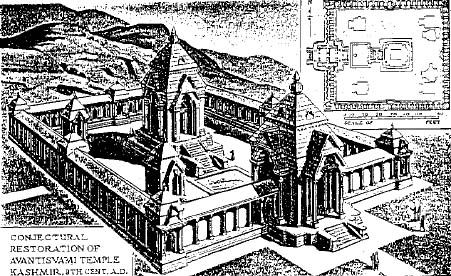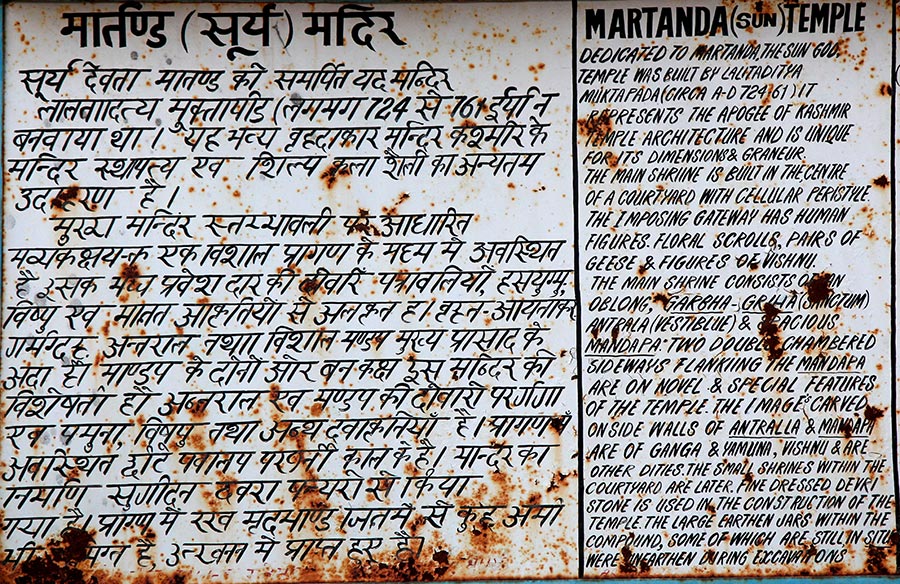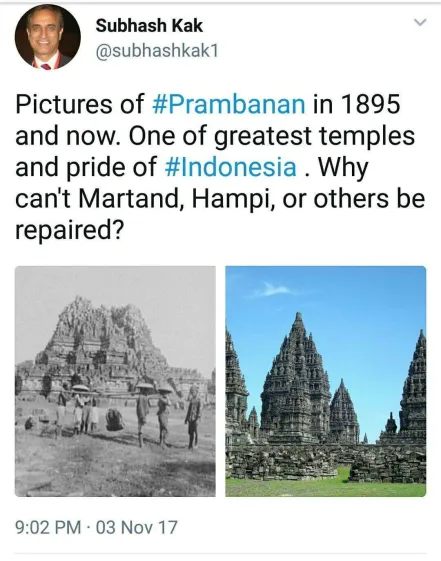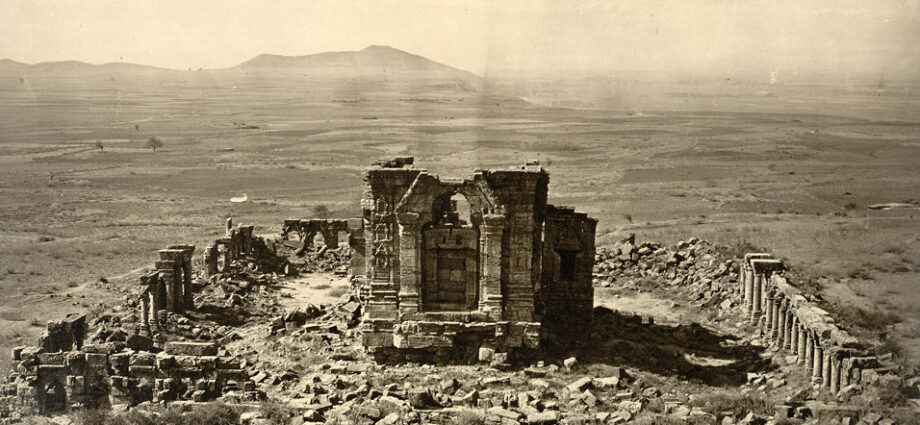Kashmiri historian Jonaraja recorded the destruction of temples in Kashmir by Sultan Sikandar Butshikan in the 1390s.
There was no city, no town, no village, no wood, where the temples of the gods were unbroken. When Sureshavari, varaha and others were broken, the world trembled, but not so the mind of the wicked king. He forgot his kingly duties and took delight day and night in breaking images.
The most prominent among such broken temples was the Martand temple in Anantnag, Kashmir, dedicated to the god Surya. It was built by the third and most famous ruler of the Karkota Dynasty, Lalitaditya Muktapida, during 725-756 and was the epitome of Hindu architecture in Kashmir. Being the Sun Temple, it faced east so that the first rays of the sun would bathe the idol of Surya. The opulence and artistic designs made it the most celebrated in the region. It had three distinct chambers—the mandapa, the garbhagriha, and the antralaya—and lines of pillars, 84 to be precise, surrounding the whole temple. It had 365 idols, one for each day of the year and was bigger than the other prominent Sun temples: Modhera in Gujarat, Multan in Sindh, and Konark in Orissa. It had Greek-style pillars, reflecting the influence of Greece. It may also be an offshoot of the Kushan Gandhara style. It had strong stone walls and a courtyard filled with water supplied by a canal from the river Lidar that glinted and sparkled in the sun. Once, it had “the magnanimity of the Egyptian temple and the grace of the Greek temple.”


The temple stood with his shikhar high for around six centuries and then things started to change suddenly.
Indian plains had already been subjugated by Islam by the late 12th century and Kashmir could not be left far behind. A particularly fanatical Sufi “saint,” Sayyid Muhammad Hamadani, arrived from central Asia and became the mentor of Sultan Sikandar. The Sufi was angry at the prevalent Hindu culture in Kashmir and started influencing the Sultan for implementing Sharia. Soon, the Sultan was on an “Islamification” mission, and his rule saw the unprecedented persecution of Hindus and the destruction of temples. Even the other ‘but-shikan’ Mahmud Ghaznavi and Aurangzeb, must not have broken so many temples as Sikander did. His chief minister, Suhabhatta, who had converted to Islam and took the name Malik Saif-ud-Din, remained involved in such activities.
Since it was the biggest temple in Kashmir, Sikandar chose it first for destruction. He formed a dedicated team of fanatic jihadis to bring down the temple. It still took him one year to destroy it. To demolish it completely, he filled the temple with wood and set it on fire. Even then, he could not demolish it totally, such was the strength of the temple. He left it as it was, in a half-demolished condition.
Legend has it that after destroying the temple, a copper plate was discovered on which the following inscription was written:
Having built this temple, was desirous of ascertaining from his astrologers how long it would last, and was informed by them that after eleven hundred years, a king named Sikandar would destroy it, as well as the other temples in Kashmir.
The king was very amazed to know that a Hindu could have predicted such a thing with such accuracy. He contemptuously declared, “Had they pasted the plate on the wall, I would have left the temple alone just to prove a Hindu astrologer wrong!”
The temples of Bijbehara, Isna, Chakrabhrit, Tripeshwar, Vijeshwar and others met with the same gruesome fate.
Historian Sayyid Ali wrote in his memoirs Tarikah-i-Kashmir about the immense destruction in Kashmir (translated by Dr. Abdul Qayum Rafiqi):
A huge temple in Sikanderpora was demolished to pave way for setting up of Jamia Masjid. In fact, in every village and town, where a temple existed, it was demolished, at the behest of Sayyid Muhammad Hamadani and a mosque built in its place. Thus, Kashmir became like a paradise.
The Hindus are trying to reclaim their temples. In May 2022, some pilgrims offered prayers inside the Martand Temple, an Archaeological Survey of India (ASI) monument. Soon after, Kashmir Lieutenant Governor Manoj Sinha participated in a “Navgrah Ashtamangalam Puja.” The ASI, a government agency and leftist to the core, objected, saying no permission was granted for the ceremony. Two months later, in July, another group of people entered the temple and held an hour-long prayer session.

Even though there is clear evidence about its demolition by Muslim sultans, many secular people are now defending the act by stating that it was ruined by earthquakes. Another set of such people stated that as more people converted to Islam, the character of existing temples was changed by removing idols and making a niche toward the Kaaba. They are even thankful to Muslims that they did not build a mosque over it. Dr. Syed Gazanfar Farooq, who has a PhD in Kashmiri architecture from Aligarh Muslim University and now works in the J&K Education Department, questioned the shoddy architecture of the temple and even opined that the foundation and structure were weak from the start, completely negating the demolition by his ancestors.
However, the cake for whitewashing goes to a Hindu, as usual. Not to be left behind in such a narrative, the 2014 Hindi film Haidar picturized a song, Bismil, wherein the temple was portrayed as “shaitan ki Gufa.”
Even after demolition and attendant ridicule, its formidable grey walls still make an impressive sight against the crystal-clear blue sky, with broken rubble strewn around the wild grass. The ruins are still the most striking object of ancient Hindu architecture in the valley. Even in their present state of decay, some of its walls still have carvings of deities, and the temple’s beauty and symmetry evident.
Many of the ancient Hindu temples have been restored and repaired in Cambodia and even in a Muslim country, Indonesia. Even in India, after much hullaballoo, Somnath and Ram Temples have been restored. In a similar way, the case can be made for the Martand temple’s restoration, but ASI would have none of it as it wants to preserve violent Islamic history.
As if it wants the broken temple to remind Hindus: “You have been butchered by the invaders, and hence, behave!”
—— Written by Amit Agarwal, author of the bestseller on Indian history titled “Swift horses Sharp Swords” and “A Never-Ending Conflict”. You may buy the books at the following link:
https://www.amazon.in/gp/product/B08KH3R4MN
https://www.amazon.in/dp/B0B6J5PKPR
https://garudabooks.com/swift-horses-sharp-swords-medieval-battles-which-shook-india-hindi (Hindi)
Twitter handle @amit1119, Instagram/ Facebook – amitagarwalauthor
Images sourced from internet.
![]()
- How Hindu rituals spawned numerous advancements in science, maths and other arts - March 13, 2024
- Naga Sadhus and their fighting skills - February 20, 2024
- Lessons for India from the Israel-Palestine conflict - October 12, 2023

